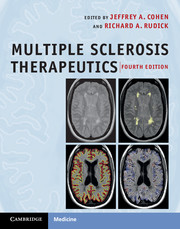Book contents
- Multiple Sclerosis Therapeutics
- Multiple Sclerosis Therapeutics
- Copyright page
- Contents
- Contributors
- Abbreviations list
- Foreword
- Preface
- Section I Introduction
- 1 Aspects of multiple sclerosis that relate to experimental therapeutics
- 2 The pathology of multiple sclerosis
- 3 The immunology of multiple sclerosis
- 4 The genetics of multiple sclerosis
- 5 The epidemiology of multiple sclerosis
- Section II Clinical trial methodology
- Section III Clinical trials of multiple sclerosis therapies
- Section IV Therapy in clinical practice
- Index
- Plate Section
3 - The immunology of multiple sclerosis
from Section I - Introduction
Published online by Cambridge University Press: 05 December 2011
- Multiple Sclerosis Therapeutics
- Multiple Sclerosis Therapeutics
- Copyright page
- Contents
- Contributors
- Abbreviations list
- Foreword
- Preface
- Section I Introduction
- 1 Aspects of multiple sclerosis that relate to experimental therapeutics
- 2 The pathology of multiple sclerosis
- 3 The immunology of multiple sclerosis
- 4 The genetics of multiple sclerosis
- 5 The epidemiology of multiple sclerosis
- Section II Clinical trial methodology
- Section III Clinical trials of multiple sclerosis therapies
- Section IV Therapy in clinical practice
- Index
- Plate Section
Summary
- Type
- Chapter
- Information
- Multiple Sclerosis Therapeutics , pp. 20 - 34Publisher: Cambridge University PressPrint publication year: 2011
- 7
- Cited by

